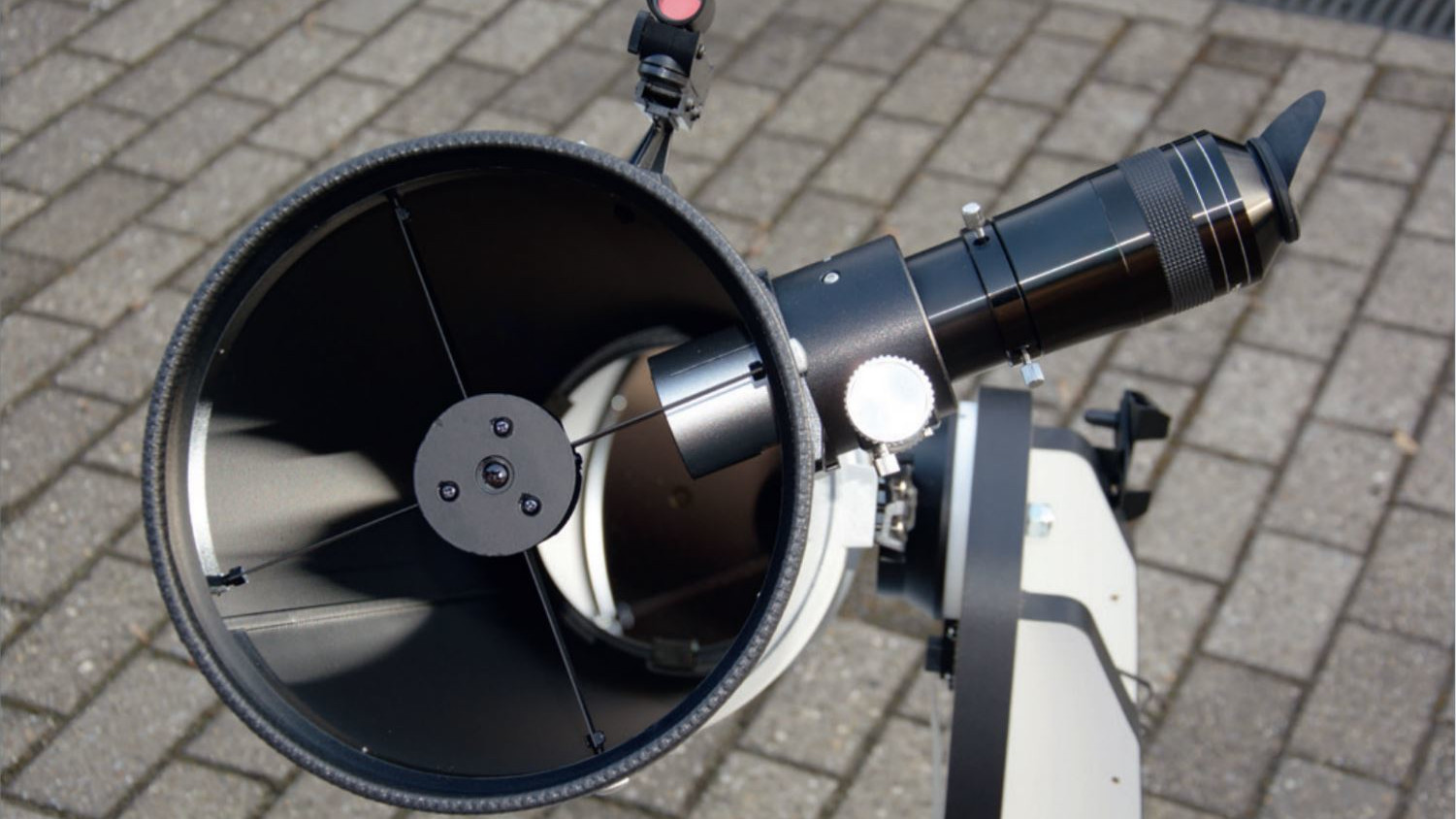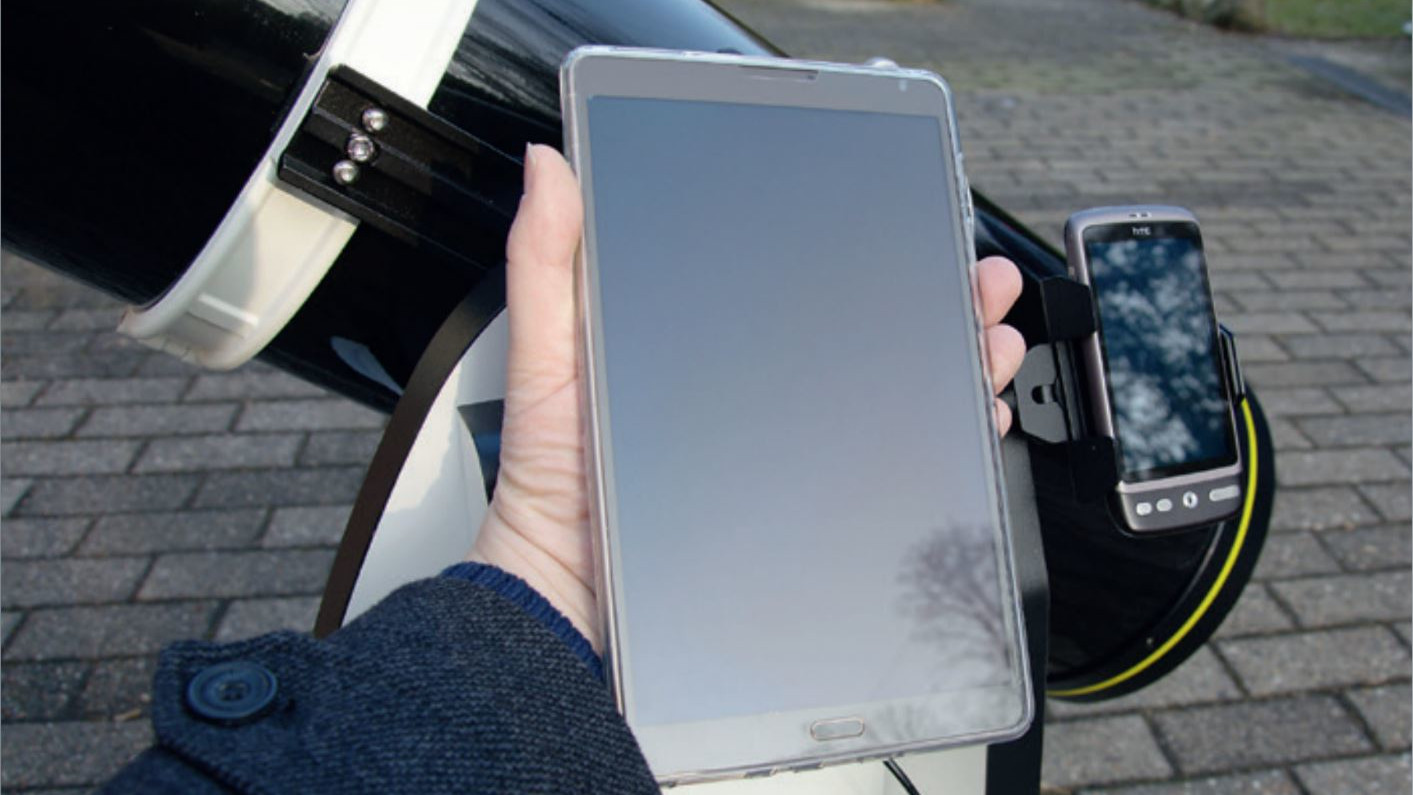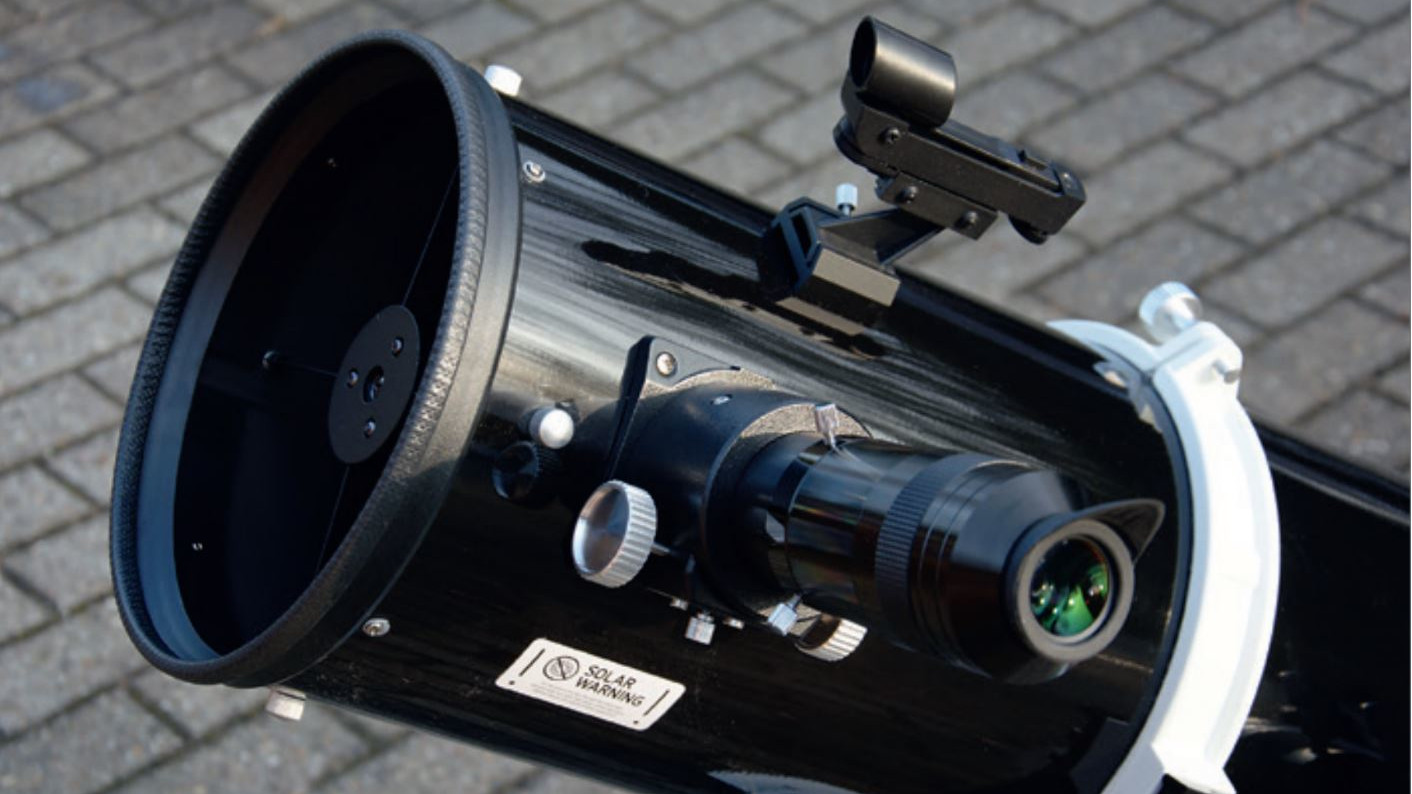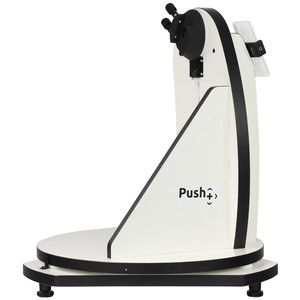Omegon Push Plus
Push Plus: a telescope halfway between manual control and GoTo system, but with modern smartphone technology.
 Review from Adventures in Astronomy, April/May 2017, author: Sven Wienstein
Review from Adventures in Astronomy, April/May 2017, author: Sven WiensteinTesting the Omegon Push+ mount with an 8 inch Newtonian
This sounds like an innovative idea for beginners, whilst at the same time capturing the zeitgeist: why not use the ever-present smartphone as a telescope control? Omegon supplies a Dobsonian mount with the Push+ system, which is capable of transmitting its positional data to almost any system over a Bluetooth connection. The mount is also offered in combination with an 8-inch Newtonian. But is it good choice for a beginner?
Omegon offers the mount individually as well as in combination with a full-size 8-inch Newtonian, the N 203/1000 – a combination that is also interesting for beginners. It is supplied in two large boxes, one each for the telescope and mount. To set up the Newtonian you only need to attach the focuser, which is fixed to the pre-installed base plate with two grub screws. Unfortunately, the 2mm Allen key required to do this is not included.
The Push+ mount requires a little more effort: it can be assembled in just over half an hour with the help of the illustrated instructions. It is a single-arm mount made of chipboard. All visible edges and surfaces are veneered, but bare chipboard can be found on some abutting edges. You should think about sealing these with diluted wood glue or something similar, if you are likely to use the mount frequently on damp nights. The somewhat unfinished pre-drilled holes should also be treated in the same way. Fortunately, almost all of these are hidden once it has been assembled. Two self-locking nuts and a supplied 17mm wrench adjust the braking effect of the slipper clutch. By the way, both axes have Teflon bearings. There is little to see of the electronics during assembly. Just a cable with a western plug to connect the encoder in the base plate with the control unit in the ascension axis housing.
An adapter cable for a car 12V DC power supply is included. A USB adapter to supply power, for example from a power bank, is also available as an accessory. Unfortunately, the socket is recessed quite deeply in the chipboard, so the usual adapter on a universal power supply may be too short. By the way, having finished assembling the mount according to the instructions, you notice that the smartphone holder still has not been attached – but there is only one screw hole left. Now you are ready to attach the telescope to the ascension axis prism rail using two clamping screws.
Free choice of program
The next step is to pair with a smartphone via Bluetooth, because without a phone and a suitable app for determining the telescope’s position, the mount would be nothing more than a normal Dobsonian mount. Omegon gives detailed information in the guide on how to connect to the Android version of SkySafari and the Windows program Cartes du Ciel. But you can also us the mount with many other programs and devices that support the IntelliScope protocol.
Once the connection has been made, the next steps depend on the control program you have selected. For the test outdoors a Nexus 7 tablet with SkySafari Pro was used. Speaking of outdoors: although the mount fits perfectly well in a small car, the carrying handle you usually expect on a Dobsonian is missing and it takes some effort to carry the 14kg mount down a staircase. It may be an acceptable solution for astrophotographers, but experience has shown that it is not enough for the visual observer. Therefore, with a certain amount of misgiving, we took a critical look at the Push+ mount and the paired smartphone.
The Nexus 7 display used here was agreeably dark – except for two Android buttons, which SkySafari could not seem to colour red. In addition, a slight purple glow from the backlight always seemed to penetrate. AMOLED or OLED displays, in which the pixels themselves light up, are a better solution. It is much worse with many other displays, where the backlight usually gives off a bluish tinge when the screen is viewed at a slightly oblique angle. If you are observing from your garden this is tolerable, because there are anyway likely to be many other light sources disturbing the darkness. However, if you have gone out of your way to find a dark location, you are unlikely to be satisfied with this. Then you will need to cover the display with a red foil.
The smartphone holder was a little disappointing: the Nexus may be a tablet, but it's a very small one – and it's too wide for the holder. But when observing, a larger display is generally preferable to a smaller one. And just when you think you have the smartphone display under control, you will find another unwanted light source. Oddly enough, the red control LED for the Bluetooth connection inside the electronics housing seems to operate in some kind of red light mode.
Also, it would have been better if the Newtonian had a carrying handle on the rings instead of a camera screw, which is useless for a Dobsonian. This would have been handy when attaching the prism rail. Before you can start observing, the software must align the telescope’s exact position. To do this, the device is moved to a horizontal starting position with the help of two markings before it is attached to the power supply. For highest precision, the instructions recommend using a spirit level to adjust the levelling feet – but it is reassuring to know that you can also do it without one.
If you are using SkySafari, you can choose two alignment objects yourself. They should not be too close together, so we chose Betelgeuse and Regulus. This should be done on lovely cold deep sky night without any disturbance from moonlight.

Important dark adaptation
As a deep sky observer, you are automatically careful to preserve your dark adaptation. Only red light is acceptable and therefore you are likely to be extremely reluctant to use a smartphone. Just one look at the screen will usually disturb your dark adaptation for the next 20 minutes. So what’s this blue LED doing here? It permanently illuminates the entire base plate of the Dobsonian through the socket for the cable connection to the lower encoder. If something shiny is lying here like a filter case, it reflects annoyingly brightly in the eye. No matter what the blue LED is doing there, the fact is that you have to seal the cable and socket in a light-proof way in order to remove this interfering light source.
It all depends on the components
Numerous telescopes fit into the Push+ mount’s prism rail. However, due to the eyepiece position, only Newtonians are likely to be useable here. Even if Omegon states that a maximum of 200mm aperture with a focal length of 1200mm is possible, I would use the N 203/1000 at the most. The device has some nice details that made a very good impression. Knurled screws are fitted for adjusting the primary mirror, whereas the secondary mirror is unfortunately adjusted with normal cross-head screws. The rear end of the tube ensures that the telescope is not sitting on the adjustment screws.
A neat plastic cap sits securely in the front, giving protection on cold nights. There was no sign of the telescope having been aligned before it left the factory. You should therefore get hold of adjustment tools, as these will be critical if you want to get the most out of the f/5 focal ratio. A fairly large centre mark is already present. As is to be expected, the tube with its high-set focuser is also designed to be used for photography – unnecessary in this case, but the telescope was not only designed for visual use. There seems to be a few bare screw heads located in and on the beam path, but the edges of the secondary mirror are blackened. Tube rings and prism rails are solid.
Accessories
A glance at the accessories, on the other hand, is a little sobering. The 25mm and 10mm Kellner eyepieces supplied with are low quality, at least they have glass lenses and some coating, but they are mounted in plastic. The eyepieces do not come close to doing justice to the large Newtonian’s potential. Of the two, the 10mm delivers the better image. The 25mm significantly loses sharpness toward the edge. The red dot finder cannot be dimmed enough so it remains too bright when the battery is fully charged, and also darkens stars due to its orange reflecting coating.
The eyepiece is uncomfortably small, even if you try looking past the finder with your other eye. For the beginner, it would have been better to dispense with these three components all together and to design the finder in such a way that any budding star fan would still be happy using it in ten years' time. In order to properly test the performance of the Newtonian, we used our own 20mm wide-field eyepiece with a 100° apparent field of view as well as a 10mm and a 4.7mm eyepiece with an 82° apparent field of view. This meant that on the one hand a larger section of the sky was visible when searching for objects, and on the other hand, the objects remain longer in the field of view, especially when using the 4.7mm eyepiece with 213x magnification. The movement of the sky due to the Earth's rotation was clearly visible. Locating objects worked well in practice.
However, this depends entirely on the features of the programs used. SkySafari, for example, uses a reticle or telrad circle to show where on the map the telescope is pointing. However, if you zoom in on the map, the reticle soon moves out of the display and it would have been nice if the program displayed some arrows to indicate which direction the telescope needs to be moved. Thus, when searching for an object, you are constantly forced to adjust either the magnification or the map section on the display. It is not a problem with the mount, more a limitation of the software recommended by Omegon.

A stroll through deep sky
The Newton made a good impression when observing. Stars looked good even with the 4.7mm eyepiece which could, for example, display the Eskimo Nebula beautifully. However, the fact that the mount was at the limit of its load capacity was demonstrated by frequent vibrations. If you touch the focuser, the device swings so fast that stars seem to become thin lines. By carefully leaning against the rubber eyecup, these vibrations can be reduced, and thus you can still focus in a usable way.
Naturally, the reticle reflects the position of the telescope very accurately in the regions of the sky near the stars that were used for alignment. That was the case with the Eskimo Nebula. However, small inaccuracies in centring on the alignment stars multiply with increasing distance, and so the reticle was about one degree off when locating the binary star cluster h & χ. This was not a problem with the wide-field eyepiece we used, but with the 25mm eyepiece supplied, it was just outside the field of view. However, in SkySafari, you can quickly select two new alignment stars that are better located for your target.
Even if you have to do this, it still takes less than three minutes to find an object from the map. If you then set the map program display to an image inversion that matches your instrument, i.e. a 180° rotation for the Newtonian, then with some practice you can also match the stars you see in the field of view to those in the map.
This gives you the certainty that you are looking at the right place in the sky, and also means that you can also find more difficult objects. For example, under a light-polluted city sky, but with an OIII filter, the Pacman Nebula NGC 281 in the constellation of Cassiopeia could be observed.
The bottom line
All in all, the N203/1000 on the PUSH+ proves itself to be a commendable, sophisticated, entry-level telescope. This is especially so because you handle the telescope yourself, you are actively involved in the search for objects and get to know the sky almost incidentally – an advantage over fully automatic GoTo telescopes.
The optics have good all-round potential. It is a really nice solution for occasional observations in the surroundings of your home and garden. If your requirements grow over the years, you are likely to become increasingly unsatisfied with its tendency to vibrate, and you will no longer be able to accept the poorly concealed blue LED. The Newtonian will be a pleasure for many years, especially if you purchase eyepieces and make small improvements, which you can find in our regular recommendations.
Retailer's comments
We carried out a series of tests and found no sections of the screen on the Samsung smartphone used in the review that were not coloured red. We were also unable to reproduce the vibrations on our device – here, some more research is probably necessary. The holder is designed and constructed as a smartphone holder – there will also be a version for tablets.
The blue light for the Bluetooth connection will be covered up in the next version. In principle, a handle for the tube is no problem – the tube rings have the aforementioned camera threads, so that a handle or a rail can be easily attached.


